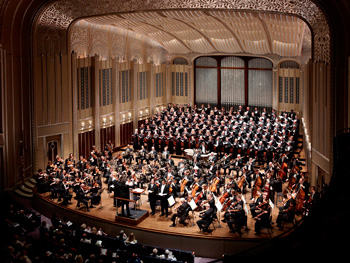by Nicholas Jones

The Romantics knew how to face death. John Keats declared himself “half in love with easeful death.” “Death is the mother of beauty,” asserted Wallace Stevens, that modernist poet with a Romantic soul. As the nineteenth century lost faith in the old ways of coping with death, they began to compensate by turning to the arts. If scripture or liturgy no longer served, the natural turn was to the artistic imagination.
Strauss was only in his mid-twenties when he wrote his tone poem about a dying artist, consumed by pain and doubt. As the title implies, the music moves through anguish to a secular apotheosis, a vision of ideal beauty.
Strauss pushes the limits of orchestration — using three of each woodwind, a full component of brass, two harps, and a stage full of strings — composing famously difficult solo lines, and calling for constantly fluctuating tempos, dynamics, and coloration. The Cleveland Orchestra proved more than capable of meeting Strauss’s demands. They led us virtuosically through the tone poem’s representations of pastoral loveliness, mystical intensity, frenetic anguish, and, at last, to stunningly gorgeous transcendence.
Among many notable individual performances were those of concertmaster William Preucil, flutist Joshua Smith, oboist Frank Rosenwein, bassoonist John Clouser, and an unidentified principal clarinetist. The big Strauss sound was well grounded by tubist Yasuhito Sugiyama’s deep and focused tones.
Franz Welser-Möst emphasized the contrasts embodied in Strauss’s music. In transitions both sudden and extended, he took the orchestra dazzlingly from soft to loud and back again, from lyrical to agitated. Unfortunately, the performance lost some potential nuances by dwelling too long in the seductions of fortissimo.
Brahms wrote A German Requiem in the 1860s in response to the death of his mother, and probably also with the death of Robert Schumann in mind. As grand in its own way as Death and Transfiguration, the Requiem is also intensely personal, rooted in the Protestant habit of self-examination. The texts, taken from Luther’s German Bible rather than from the liturgy for the dead, are melancholy with tears and sorrow, but balanced by the promise of patience, consolation, and peace.
The Requiem begins almost imperceptibly in quietness and returns to that dynamic again and again, until, all passion spent, it ends again in near silence. The exceptional voices of The Cleveland Orchestra Chorus made those quiet moments the emotional core of the piece, singing with hushed tones but no lack of intensity or focus. In “So seid nun geduldig” in the second movement, for example, a beautiful flute obbligato could easily get lost under the singing; here, it sparkled as a representation of the patience of the farmer who waits for rain and the ripening of “the precious fruit of the earth.”
The chorus was splendid, as well, in the more active moments, confidently negotiating the tricky fugal passages. They also excelled in Brahms’s abruptly articulated phrases — as when the text promises with Teutonic intensity that “pain and suffering will flee away.” The famous lines from First Corinthians, “Death, where is your sting? Hell, where is your victory?” came across with stabbingly combative assertion:“Tod, wo ist dein Stachel? / Hölle, wo ist dein Sieg?”
In “Herr, lehre doch mich,” the inquiring soul faces God, crying out for knowledge. Baritone Dashon Burton sang the solo with a commanding presence, but the effect was lessened by some uncertainty in rhythm. Soprano soloist Lauren Snouffer delivered a beautiful message of consolation with her soaring line, “I will comfort you as a mother comforts,” lovingly supported by winds and horn.
Welser-Möst conducted the Requiem with consistent attention to the often anguished phrasings of Brahms’s brilliant text-setting. Even in the pastoral grace of “Wie lieblich sind deine Wohnungen,” the soul longs (“verlanget”) and faints (“und sehnet”) for heaven, and the performance made much of that passionate pulsation.
Brahms builds wonderfully long lines, melodies that feel as if drawn out from the soul without hesitation or uncertainty — as in “Denn alles Fleisch es ist wie Gras / und alle Herrlichkeith des Menschen / wie des Grases Blumen.” Perhaps in an effort to emphasize the diction, the chorus too often gave these lines a choppy articulation, singing in short segments rather than in a soaring arc of melody.
This was a long, ambitious, and intense program, daring in its seriousness — and a complete contrast to the disco music that followed in the lobby and on the terrace afterwards.
The two remaining programs in Summers@Severance include the finals of the Thomas and Evon Cooper International Piano Competition (July 22, with Jahja Ling), and a sunny program of Bach, Handel, and Mozart conducted by Bernard Labadie (August 12).
Published on ClevelandClassical.com July 12, 2016.
Click here for a printable copy of this article



